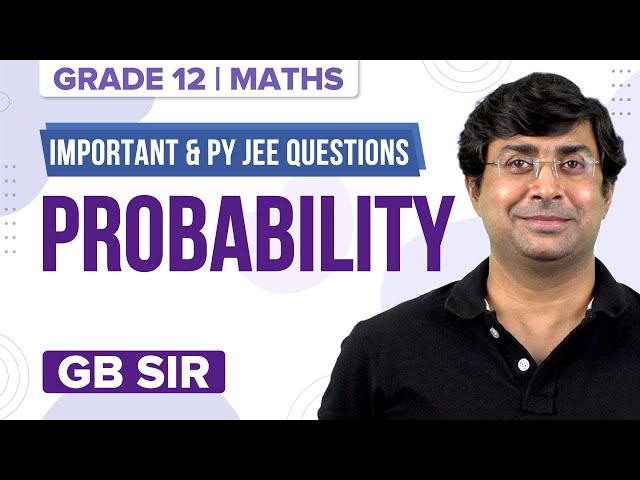Probability JEE Advanced previous year questions with solutions are given on this page.
Probability is a branch of mathematics that deals with the occurrence of a random event. The value is expressed from zero to one. The important topics include conditional probability, Baye’s theorem, independent events, etc. Students can expect one question from this topic. Students can also download these solutions in PDF format for offline use.
Download Probability Previous Year Solved Questions PDF
JEE Advanced Maths Probability Previous Year Questions with Solutions
Question 1: A die is thrown two times and the sum of the scores appearing on the die is observed to be a multiple of 4. Then the conditional probability that the score 4 has appeared atleast once is:
a) 1/3
b) 1/4
c) 1/8
d) 1/9
Solution:
Let A be the event that the sum obtained is a multiple of 4.
B be the event that the score of 4 has appeared at least once.
A = {(1, 3), (2, 2), (3, 1), (2, 6), (3, 5), (4, 4), (5, 3), (6, 2), (6, 6)}
B = {(1, 4), (2, 4), (3, 4), (4, 4), (5, 4), (6, 4), (4, 1), (4, 2), (4, 3), (4, 5), (4, 6)}
(A ∩ B) = (4, 4)
n(A ∩ B) = 1
Required probability = P(B/A)
= P(A ∩ B)/P(A)
= 1/9
Hence option d is the answer.
Question 2: There are three bags B1, B2, and B3. The bag B1 contains 5 red and 5 green balls, B2 contains 3 red and 5 green balls, and B3 contains 5 red and 3 green balls, Bags B1, B2 and B3 have probabilities 3/10, 3/10, and 4/10 respectively of being chosen. A bag is selected at random and a ball is chosen at random from the bag. Then which of the following options is/are correct?
(a) Probability that the selected bag is B3 and the chosen ball is green equals 3/10
(b) Probability that the chosen ball is green equals 39/80
(c) Probability that the chosen ball is green, given that the selected bag is B3, equals 3/8
(d) Probability that the selected bag is B3, given that the chosen balls is green, equals 5/13
Solution:
(i) P(B3⋂G) = P(G/B3).P(B3)
= (⅜) × (4/10)
= 3/20
(ii) P(G) = (5/10)×(3/10) + (⅝)×(3/10) + (⅜)×(4/10)
= (60 + 75 + 60)/400
= 195/400
= 39/80
(iii) P(G/B3) = 3/8
(iv) P(B3/G) = P(G⋂B3)/P(G)
= (3/20)/(39/80)
= 4/13
Hence option b and c are correct.
Question 3: A box contains 15 green and 10 yellow balls. If 10 balls are randomly drawn, one-by-one, with replacement, then the variance of the number of green balls drawn is :
(a) 6
(b) 4
(c) 6/25
(d) 12/5
Solution:
Probability of getting a green ball, p = 15/25
= ⅗
Probability of getting a yellow ball, q = 10/25
= ⅖
n = 10
var (X) = npq
= 10 ×(3/5) × (2/5)
= 10 × (6/25)
= 12/5
Hence option d is the answer.
Question 4: For three events A, B, and C, P (Exactly one of A or B occurs) = P (Exactly one of B or C occurs) = P (Exactly one of C or A occurs) = 1 / 4 and P (All the three events occur simultaneously) = 1 / 16. Then the probability that at least one of the events occurs is :
(a) 7/16
(b) 7/64
(c) 3/16
(d) 7/32
Solution:
P(A) + P(B) – 2P(A ⋂ B) = 1/4
P(B) + P(C) – 2P(B ⋂ C) = 1/4
P(C) + P(A) – 2P(A ⋂ C) = ¼
Adding all these equations together and simplifying
P(A) + P(B) + P(C) – P(A ⋂ B) – P(B ⋂ C) – P(A ⋂ C) = 3/8
Since P(A ⋂ B ⋂ C) = 1/16
So P(A ⋃ B ⋃ C) = (3/8) + (1/16) = 7/16
Hence option a is the answer.
Question 5: If two different numbers are taken from the set {0, 1, 2, 3, ……, 10}; then the probability that their sum, as well as absolute difference, are both multiples of 4, is :
(a) 12/55
(b) 14/45
(c) 7/55
(d) 6/55
Solution:
Total number of ways = 11C2 = 55
Favourable ways are (0, 4), (0, 8), (4, 8), (2, 6), (2, 10), (6, 10)
Required probability = 6/55
Hence option d is the answer.
Question 6: A bag contains 4 red and 6 black balls. A ball is drawn at random from the bag, its colour is observed and this ball along with two additional balls of the same colour are returned to the bag. If now a ball is drawn at random from the bag, then the probability that this drawn ball is red, is :
(a) 1/5
(b) 3/4
(c) 3/10
(d) 2/5
Solution:
There are 2 possible cases: first ball drawn is red or is black.
P(first ball black) = 6/10
P(first ball red) = 4/10
P(second ball red | first ball drawn is black) = 4/12
P(second ball red | first ball drawn is red) = 6/12 = 1/2
From total Probability Theorem
The probability of the second ball being red, P(R) = (4/10)×(1/2)+(6/10) ×(4/12)
= (1/5)+(1/5)
= 2/5
Hence option (d) is the answer.
Passage for Question 7 and Question 8:
Let U1 and U2 be two urns such that U1 contains 3 white and 2 red balls, and U2 contains only 1 white ball. A fair coin is tossed. If head appears then 1 ball is drawn at random from U1 and put into U2. However, if tail appears then 2 balls are drawn at random from U1 and put into U2. Now 1 ball is drawn at random from U2.
Question 7: Given that the drawn ball from U2 is white, the probability that head appeared on the coin is
(a) 17/23
(b) 11/23
(c) 15/23
(d) 12/23
Solution:
Use Baye’s theorem
Required probability = P(H/W)
= [P(W∣H)×P(H)]/[P(W/T). P(T) + P(W/H).P(H)]
= ½ (⅗ ×1 + ⅖ × ½ )/(23/30)
= 12/23
Hence option (d) is the answer.
Question 8: The probability of the drawn ball from U2 being white is
(a) 13/30
(b) 23/30
(c) 19/30
(d) 11/30
Solution:
P(W) = P(H, W) + P(T, W)
If head comes then W or R from U1 and U2 will contain 3W or 1W 1R
P(H, W) = ½ (⅗ × 1 + ⅖ × ½ )
= ⅖
If tail comes, then WW or RR or WR from U1 and U2 will have 3W or 1W 2R or 2W R
P(T, W) = ½ [(3/10) × 1 + (1/10) × ⅓ + (6/10) × ⅔]
= 11/30
P(W) = ⅖ + 11/30
= (12 + 11)/30
= 23/30
Hence option (b) is the answer.
Question 9: Four persons independently solve a certain problem correctly with probabilities 1/2, 3/4, 1/4, 1/8. Then the probability that the problem is solved correctly by at least one of them is
(a) 235/256
(b) 21/256
(c) 3/256
(d) 253/256
Solution:
P(A) = 1/2
P(A’) = 1-½ = ½
P(B) = ¾
P(B’) = 1 – ¾ = ¼
P(C) = ¼
P(C’) = 1 – ¼ = ¾
P(D) = ⅛
P(D’) = 1 – ⅛ = ⅞
P(at least one of them solves correctly) = 1 – P(none of them solves correctly)
= 1 – (½ × ¼ × ¾ × ⅞ )
= 1 – 21/256
= 235/256
Hence option (a) is the answer.
Question 10: A seven-digit number is formed using the digit 3, 3, 4, 4, 4, 5, 5. The probability, that number so formed is divisible by 2, is:
(a) 6/7
(b) 4/7
(c) 3/7
(d) 1/7
Solution:
n(S) = 7!/[2! 3! 2!]
n(E) = 6!/[2! 2! 2!]
P(E) = n(E)/n(S)
= [6! / 7!] × [[2! 3! 2!] / [2! 2! 2!]]
= 3/7
Hence option c is the answer.
Probability JEE Advanced PY Questions

Probability – JEE Advanced Solved Questions

Also Read
Probability JEE Main Previous Year Questions With Solutions
Probability – Important Topics

Probability – Important Questions

Comments